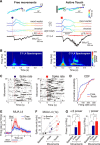The Nature of the Sensory Input to the Neonatal Rat Barrel Cortex
- PMID: 27656029
- PMCID: PMC6705573
- DOI: 10.1523/JNEUROSCI.1781-16.2016
The Nature of the Sensory Input to the Neonatal Rat Barrel Cortex
Abstract
Sensory input plays critical roles in the development of the somatosensory cortex during the neonatal period. This early sensory input may involve: (1) stimulation arising from passive interactions with the mother and littermates and (2) sensory feedback arising from spontaneous infant movements. The relative contributions of these mechanisms under natural conditions remain largely unknown, however. Here, we show that, in the whisker-related barrel cortex of neonatal rats, spontaneous whisker movements and passive stimulation by the littermates cooperate, with comparable efficiency, in driving cortical activity. Both tactile signals arising from the littermate's movements under conditions simulating the littermates' position in the litter, and spontaneous whisker movements efficiently triggered bursts of activity in barrel cortex. Yet, whisker movements with touch were more efficient than free movements. Comparison of the various experimental conditions mimicking the natural environment showed that tactile signals arising from the whisker movements with touch and stimulation by the littermates, support: (1) a twofold higher level of cortical activity than in the isolated animal, and (2) a threefold higher level of activity than in the deafferented animal after the infraorbital nerve cut. Together, these results indicate that endogenous (self-generated movements) and exogenous (stimulation by the littermates) mechanisms cooperate in driving cortical activity in newborn rats and point to the importance of the environment in shaping cortical activity during the neonatal period.
Significance statement: Sensory input plays critical roles in the development of the somatosensory cortex during the neonatal period. However, the origins of sensory input to the neonatal somatosensory cortex in the natural environment remain largely unknown. Here, we show that in the whisker-related barrel cortex of neonatal rats, spontaneous whisker movements and passive stimulation by the littermates cooperate, with comparable efficiency, in driving cortical activity during the critical developmental period.
Keywords: EEG; barrel; development; neonate; whisker.
Copyright © 2016 the authors 0270-6474/16/369922-11$15.00/0.
Figures




Similar articles
-
Self-Generated Whisker Movements Drive State-Dependent Sensory Input to Developing Barrel Cortex.Curr Biol. 2020 Jun 22;30(12):2404-2410.e4. doi: 10.1016/j.cub.2020.04.045. Epub 2020 May 14. Curr Biol. 2020. PMID: 32413304 Free PMC article.
-
Imprecise Whisker Map in the Neonatal Rat Barrel Cortex.Cereb Cortex. 2015 Oct;25(10):3458-67. doi: 10.1093/cercor/bhu169. Epub 2014 Aug 6. Cereb Cortex. 2015. PMID: 25100857
-
Structure, function, and cortical representation of the rat submandibular whisker trident.J Neurosci. 2013 Mar 13;33(11):4815-24. doi: 10.1523/JNEUROSCI.4770-12.2013. J Neurosci. 2013. PMID: 23486952 Free PMC article.
-
Sensorimotor processing in the rodent barrel cortex.Nat Rev Neurosci. 2019 Sep;20(9):533-546. doi: 10.1038/s41583-019-0200-y. Epub 2019 Jul 31. Nat Rev Neurosci. 2019. PMID: 31367018 Free PMC article. Review.
-
Information processing streams in rodent barrel cortex: the differential functions of barrel and septal circuits.Cereb Cortex. 2008 May;18(5):979-89. doi: 10.1093/cercor/bhm138. Epub 2007 Aug 16. Cereb Cortex. 2008. PMID: 17702950 Review.
Cited by
-
The evolving neurobiology of early-life stress.Neuron. 2025 May 21;113(10):1474-1490. doi: 10.1016/j.neuron.2025.02.016. Epub 2025 Mar 17. Neuron. 2025. PMID: 40101719 Review.
-
Developmental trajectory of movement-related cortical oscillations during active sleep in a cross-sectional cohort of pre-term and full-term human infants.Sci Rep. 2018 Nov 30;8(1):17516. doi: 10.1038/s41598-018-35850-1. Sci Rep. 2018. PMID: 30504857 Free PMC article.
-
Protosequences in brain organoids model intrinsic brain states Authors.bioRxiv [Preprint]. 2025 Jan 8:2023.12.29.573646. doi: 10.1101/2023.12.29.573646. bioRxiv. 2025. PMID: 38234832 Free PMC article. Preprint.
-
Electrical activity controls area-specific expression of neuronal apoptosis in the mouse developing cerebral cortex.Elife. 2017 Aug 21;6:e27696. doi: 10.7554/eLife.27696. Elife. 2017. PMID: 28826501 Free PMC article.
-
Transient cortical circuits match spontaneous and sensory-driven activity during development.Science. 2020 Oct 16;370(6514):eabb2153. doi: 10.1126/science.abb2153. Science. 2020. PMID: 33060328 Free PMC article. Review.
References
Publication types
MeSH terms
LinkOut - more resources
Full Text Sources
Other Literature Sources
